Olympic mascot facts for kids
The Olympic mascots are fictional characters, usually an animal native to the area or human figures, who represent the cultural heritage of the place where the Olympic and Paralympic Games are taking place. The mascots are often used to help market the Olympic Games to a younger audience, in particular toddlers and children. Ever since the 1932 Summer Olympics in Los Angeles, California, the Olympic Games have always had a mascot. The first major mascot in the Summer Olympic Games was Misha in the 1980 Summer Olympics in Moscow. Starting with the 2010 Vancouver mascots, the Olympic and Paralympic mascots have been presented together.
History
The first Olympic mascot was born at the Grenoble Olympic Games in 1968. It was named "Schuss" and it was a little man on skis, designed in an abstract form and painted in the colors of France: blue, red and white. However, the first official Olympic mascot appeared in the 1972 Summer Olympics in Munich. It was Waldi, a Dachshund dog, a popular breed in Bavaria and it represented the attributes required for athletes – resistance, tenacity and agility. On it were three of the colors of the Olympic flag (blue, yellow, green).
The success of those first mascots helped the idea of a mascot become a symbol of the Olympic Games and developed into an institution. Mascots are very popular and despite the importance of the message they convey, they are designed in simple manner with bright, happy colors appropriate for the 'festive' atmosphere of the Olympic Games.
Olympic mascots
| Games | City | Mascot | Character | Designer | Significance | Image |
|---|---|---|---|---|---|---|
| 1932 Summer Olympics | Los Angeles | Smoky | Scottish terrier | Born in the Olympic Village before the Olympics | official | |
| 1968 Winter Olympics | Grenoble | Schuss | Stylized skier | Aline Lafargue | (unofficial) | |
| 1968 Summer Olympics | Mexico City | Red Jaguar | (unofficial) | |||
| 1972 Summer Olympics | Munich | Waldi | Dachshund dog | Otl Aicher | A popular breed in Bavaria, it represented the attributes required for athletes – resistance, tenacity and agility. | |
| 1976 Winter Olympics | Innsbruck | Schneemann | Snowman | Walter Pötsch | It represents the Games of Simplicity. | |
| 1976 Summer Olympics | Montreal | Amik | Beaver | Yvon Laroche, Pierre-Yves Pelletier, Guy St-Arnaud and George Huel |
One of the national symbols of Canada. | |
| 1980 Winter Olympics | Lake Placid | Roni | Raccoon | Donald Moss | Its face design resembles the hat and goggles used by competitors. Named for the Adirondack mountain range. | |
| 1980 Summer Olympics | Moscow | Misha | Bear cub | Victor Chizhikov | The bear was the national symbol of the Soviet Union. | 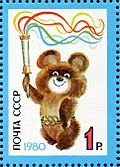 |
| 1984 Winter Olympics | Sarajevo | Vučko | Little wolf | Joze Trobec | Symbolizing the desire of humans to befriend animals. According to the IOC, it helped change the common perception in the region of wolves as frightening and blood-thirsty. | |
| 1984 Summer Olympics | Los Angeles | Sam | Bald eagle | Robert Moore (from The Walt Disney Company) |
The symbol of the United States. | |
| 1988 Winter Olympics | Calgary | Hidy and Howdy | Two polar bears | Sheila Scott | Both represent Western Canadian hospitality. | |
| 1988 Summer Olympics | Seoul | Hodori | Tiger cub | Hyun Kim | Common in Korean legends. | |
| 1992 Winter Olympics | Albertville | Magique | Man-star/snow imp | Philippe Mairesse | ||
| 1992 Summer Olympics | Barcelona | Cobi | A Catalan sheepdog | Javier Mariscal | Drawn in avant-garde, cubist style | 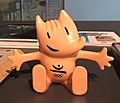 |
| 1994 Winter Olympics | Lillehammer | Håkon and Kristin | Two Norwegian children | Both are dressed in Viking clothes. First mascots to be human figures. | ||
| 1996 Summer Olympics | Atlanta | Izzy | An abstract figure (an alien) | John Ryan | The first computer-generated mascot. | |
| 1998 Winter Olympics | Nagano | The Snowlets: Sukki, Nokki, Lekki and Tsukki |
Four owls | Representing the four major islands of Japan. The first syllable of each name combines phonetically to create the word "Snowlets". | ||
| 2000 Summer Olympics | Sydney | Olly (from "Olympic") |
Kookaburra | Jozef Szekeres, Matthew Hatton | Representing the Olympic spirit of generosity. | |
| Syd (from "Sydney") |
Platypus | Representing the environment and energy of the people of Australia. | ||||
| Millie (from "Millennium") |
Echidna | Representing the Millennium. All three mascots are common wild animals found in Australia. | ||||
| 2002 Winter Olympics | Salt Lake City | Powder (a.k.a. Swifter) |
Snowshoe hare | Steve Small, Landor Associates and Publicis |
All three mascots are indigenous animals of the U.S. state of Utah, and are named after natural resources important to the state's economy. These animals are major characters in the legends of local American Indians, and these legends are reflected in the story of each mascot. To remind them of this heritage, all mascots wear a charm around their neck with a petroglyph image. | |
| Copper (a.k.a. Higher) |
Coyote | |||||
| Coal (a.k.a. Stronger) |
American black bear | |||||
| 2004 Summer Olympics | Athens | Athena and Phevos | Brother and sister | Spyros Gogos | Two modern children resembling ancient Greek dolls. | |
| 2006 Winter Olympics | Turin | Neve and Gliz | A humanized snowball and ice cube | Pedro Albuquerque | "Snow and Ice". Neve ("Snow" in Italian) is a humanized female snowball that wears red and represents "softness, friendship and elegance." Gliz (a shortened form of Ghiaccio, "Ice" in Italian) is a humanized male ice cube who wears blue and represents "enthusiasm and joy." |  |
| 2008 Summer Olympics | Beijing | The Fuwa: Beibei, Jingjing, Huanhuan, Yingying, Nini |
Koi, giant panda, Olympic Flame, Tibetan antelope, swallow | Han Meilin | The five names form the Chinese phrase "Beijing huan ying ni" (北京欢迎你), which means "Beijing welcomes you". Each representing an Olympic ring and Feng Shui element. |  |
| 2010 Winter Olympics | Vancouver | Miga | Mythical sea bear | Meomi Design (a group of Vicki Wong and Michael Murphy) |
Part orca and part kermode bear | 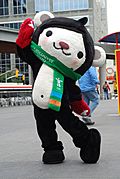 |
| Quatchi | A sasquatch | From Canadian mythology | 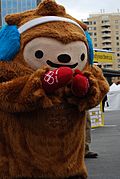 |
|||
| Mukmuk | A Vancouver Island marmot | Not an official mascot, but their designated "sidekick". | ||||
| 2012 Summer Olympics | London | Wenlock | A drop of steel with a camera for an eye. | Iris | Named after the village of Much Wenlock in Shropshire – which hosted a precursor to the modern Olympic Games in the 19th century. It represents the UK's start of the Industrial Revolution. |  |
| 2014 Winter Olympics | Sochi | Bely Mishka (Polar Bear), Snow Leopard (leopard), Zaika (the dore hare) | Silvia Petrova, Vadim Pak, Oleg Serdechny | First mascots decided by popular vote. |  |
|
| 2016 Summer Olympics | Rio de Janeiro | Vinicius | A hybrid animal representing all Brazilian mammals | Luciana Eguti and Paulo Muppet | Inspired by Brazilian fauna. Named after the poet and bossa nova composer Vinicius de Moraes decided by popular vote. | |
| 2018 Winter Olympics | Pyeongchang | Soohorang | A white tiger | MASS C&G | A white tiger. The tiger is an animal closely related to Korean mythology, and is a symbol of trust, strength, and protection. | 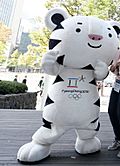 |
| 2020 Summer Olympics | Tokyo | Miraitowa | A robot with blue chequered patterns from the official emblem | Ryo Taniguchi | A superhero-inspired character that embodies both old tradition and new innovation. The olympic mascot was chosen from several designs submitted by schoolchildren and illustrators throughout Japan. | |
| 2022 Winter Olympics | Beijing | Bing Dwen Dwen | A giant panda. | Cao Xue | With a suit of ice, a heart of gold and a love of all things winter sports, this panda is ready to share the true spirit of the Olympics with the whole world. | |
| 2024 Summer Olympics | Paris | Will be unveiled in late 2021 or 2022 | TBA | TBA | ||
| 2026 Winter Olympics | Milan-Cortina d'Ampezzo | Will be unveiled in late 2024 | TBA | TBA | ||
| 2028 Summer Olympics | Los Angeles | Will be unveiled in late 2026 | TBA | TBA |
Youth Olympic mascots
| Games | City | Mascot | Character | Designer | Significance | Picture |
|---|---|---|---|---|---|---|
| 2010 Summer Youth Olympics | Singapore | Lyo and Merly | Red male lion (Lyo), Blue female merlion (Merly) | Cubix International | The two characters are an allusion to the "Lion City" label of Singapore, and the Merlion, a national symbol of Singapore, respectively. |  |
| 2012 Winter Youth Olympics | Innsbruck | Yoggl | Alpine Chamois | Florencia Demaría and Luis Andrés Abbiati of Argentina | Yoggl represents the character of the host city of these games |  |
| 2014 Summer Youth Olympics | Nanjing | Lele (mascot)(砳砳) | Rainflower Stone/Yuhua Stone (雨花石) | LeLe is inspired by a unique natural feature of the host city known as the "Rain-Flower Pebble" (also translated as "Riverstone"). The design of the mascot takes the typical shape and appearance of this stone but in a creative and artistic way, highlighting the colours from the emblem's palette. The word 'lele' represents the sound of stones colliding together and is pronounced like the Chinese word meaning happiness or joy. |  |
|
| 2016 Winter Youth Olympics | Lillehammer | Sjogg | Lynx | Line Ansethmoen |  |
|
| 2018 Summer Youth Olympics | Buenos Aires | Pandi | Jaguar | Human Full Agency | Pandi is young jaguar. Its name "#Pandi" is a combination of the scientific name of the species (Panthera onca) and the relationship of the mascot with the "digital world". |  |
| 2020 Winter Youth Olympics | Lausanne | Yodli | A cow, Saint Bernard dog and a goat hybrid. | ERACOM | A yodel singing technique, popular in Switzerland and in areas of France, was the inspiration for the name of the masoct. Yodli is a cross between a cow, goat and the Saint Bernard breed of dog, all of which are commonly found in the Swiss mountains. |  |
| 2024 Winter Youth Olympics | Gangwon Province | TBA | TBA | TBA | ||
| 2026 Summer Youth Olympics | Dakar | TBA | TBA | TBA |
Images for kids
See also
 In Spanish: Mascota de los Juegos Olímpicos para niños
In Spanish: Mascota de los Juegos Olímpicos para niños



